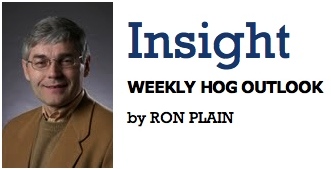July 2, 2012 - USDA’s June hogs and pigs report said the market hog inventory was slightly smaller than pre-release trade forecasts and the breeding herd inventory were slightly larger than pre-release trade forecasts. USDA said the market inventory was up 0.8% and kept for breeding was up 1.0%. USDA’s estimate of the total number of hogs and pigs on U.S. farms at the start of June was 0.8% larger than 12 months earlier. (See Table 1) The average of the pre-release trade estimates was for a 1.4% increase in the market hog inventory, a 0.7% increase in the swine breeding herd, and a 1.3% increase in the total inventory.
USDA made some upward revisions to past inventory estimates to bring them more in line with spring hog slaughter. USDA raised their previous estimate of the March market hog inventory by 210,000 head (0.4%), increased the reported number of sows farrowed during September-November 2011 by 35,000 (1.2%) and increased the September-November pig crop by 351,000 head (1.2%).
The June swine breeding herd is 42,000 head larger than on March 1 and the largest since September 2009. In 2011, the June breeding herd inventory was 15,000 head larger than on March 1. Thus, USDA says the breeding herd grew by 27,000 head this spring compared to last. March-May sow slaughter was down by 18,000 head compared to a year ago. Imports of Canadian sows for slaughter was up by 2,600, leaving 15,400 fewer U.S. sows slaughtered this winter than last. The USDA data implies 11,600 more gilts were added to the breeding herd this spring than last. This is far more than indicated by our gilt slaughter data.
USDA said spring (March-May) farrowings were up 0.1% from a year ago. They forecast summer farrowings to be down 0.9% and fall farrowings to be down 1.3% compared to 12 months earlier. (See Table 3) Spring farrowings were 0.5% greater than trade expectations. USDA’s forecast of summer farrowings is 0.1% lower than expected and fall farrowing intentions are 1.0% below the trade forecast. USDA says the breeding herd is up 1.0%, but the number of litters to be farrowed in the next six months will be down 1.1%. History shows farrowing intentions to be a better predictor of future hog slaughter than is the breeding herd inventory.
The number of pigs per litter during March-May, 10.09 head, was up 0.6% from a year ago. The trade was expecting a 1.3% increase. The 10.09 head was a new record, but the 0.6% increase was the smallest since June-August 2006. Spring farrowings were up 0.1% and with 0.6% more pigs per litter, the spring pig crop was up 0.6%.
USDA’s survey indicated the number of market hogs weighing 180 pounds or more on June 1 was up 0.5% compared with 12 months earlier. (See Table 2) It looks like daily barrow and gilt slaughter in June was up 0.1%. The 120-179 pound market hog group was up 1.4% from June 2011. The 50-179 pound inventory was up 1.2%; and the inventory of pigs weighing less than 50 pounds was up 0.1% compared to a year earlier.
Live animal imports from Canada during the March-May quarter showed feeder pigs up 4.4% and slaughter hog imports down 15.0%. Imports of Canadian hogs and pigs for 2011 totaled 5.8 million head. Look for 2012 imports to be close to that same level.
Based on the 50-179 pound market hog inventory and the expectation of little change in live hog imports, our forecast is for an increase of 1.3% in third quarter 2012 daily hog slaughter. With this level of pork production, we expect 51-52% lean hogs to average in the high $60s live and Iowa-Minnesota negotiated sales to average close to $92/cwt on a carcass weight basis.
For the fourth quarter of 2012 we expect hog slaughter to be up 0.8% on a daily basis with 51-52% lean hogs averaging close to $60 live and Iowa hogs averaging around $80/cwt on a carcass basis.
With the number of litters farrowed expected to be down 0.9% this summer and pigs per litter increasing by 1.5% or so, the summer pig crop is likely to be 0.6% above a year earlier. We are forecasting first quarter 2013 daily slaughter to be up 0.6% compared to a year ago. Look for carcass prices of barrows and gilts to average in the low $80s/cwt. Slaughter weights are likely to average 0.5% higher.
The forecast 1.3% decrease in fall farrowings should be offset by an increase in litter size to yield a fall pig crop a bit above a year-earlier causing second quarter 2013 hog slaughter to be up 0.2% on a daily basis.
Our estimates of slaughter and prices for the next four quarters are in Table 4. We expect 2012 pork production to be 2.4% higher than in 2011 and hog prices to be $4/cwt or so lower than last year.



